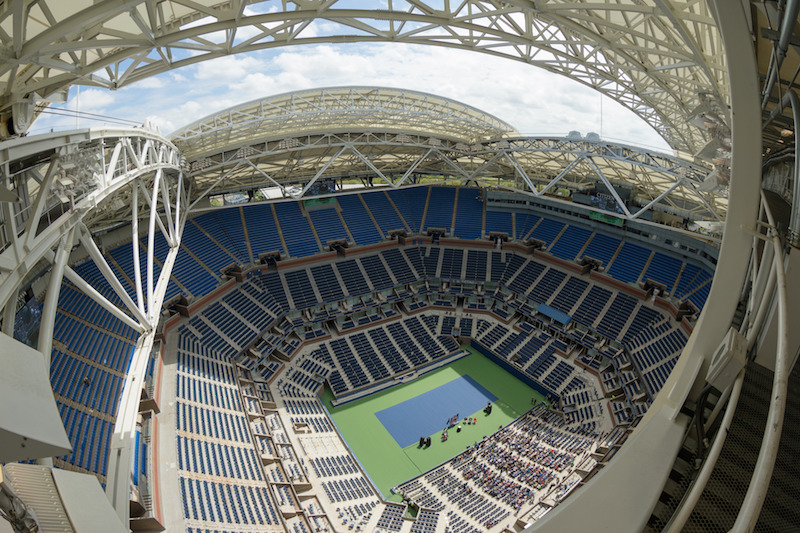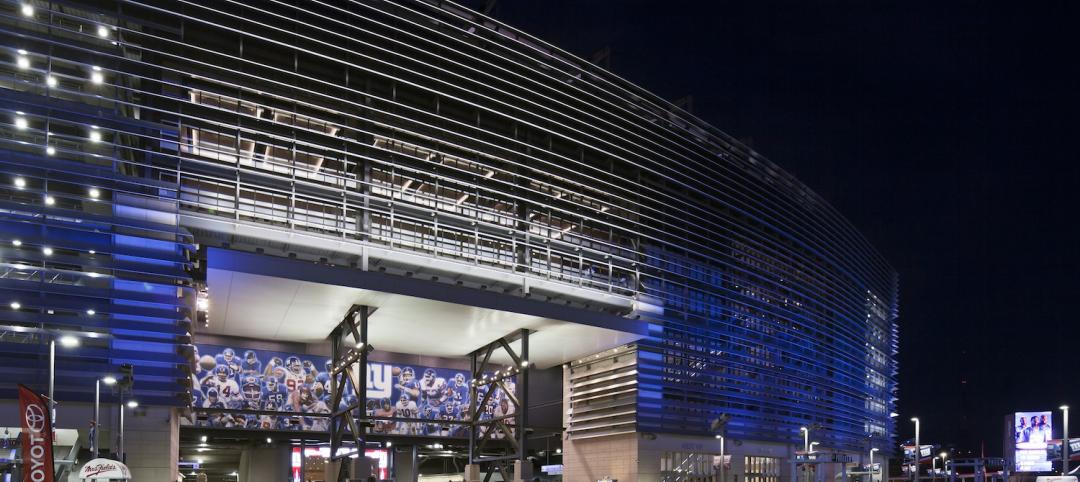As the U.S. Open Grand Slam tennis tournament in New York moves into its second week, the massive retractable roof over the 23,711-seat Arthur Ashe stadium has been drawing oohs and aahs from players and fans alike.
The $150 million roof addition is part of a $550 million renovation of the Billie Jean King National Tennis Center in Flushing, Queens. The roof itself was five years in the making, and posed several structural and engineering challenges to the Building Team, which included the architect Rossetti, the engineering firm WSP | Parsons Brinckerhoff, and the general contractor Hunt Construction Group.
This morning, BD+C interviewed WSP | Parsons Brinckerhoff execs Ahmad Rahimian, P.E., SE, F.ASCE, director of Building Structures; and Yoram Eilon, P.E., Senior Vice President of Building Structures, about this project.
Rahimian noted that any stadium construction or renovation is complicated. This one, though, was unique in several ways. For one thing, there was no precedent to draw upon in the tennis world, as Arthur Ashe is by far the largest stadium on the tour. And that facility, which opened in August 1977, wasn’t designed to include a roof.
Rahimian said that the U.S. Tennis Association (USTA), which owns and operates the venue and annual event, actually started thinking about a roof three years after the stadium opened. Those plans became more urgent in 2008, when rain interfered with the completion of some matches. Since then, rain has been a perennial threat, and occasional impediment, to the tournament’s scheduling. Design discussions for a roof began around 2011, he said.
Given the stadium’s age and structural condition, the Building Team concluded that the best solution would be to build a freestanding structure for the retractable roof that doesn’t touch the stadium itself. (There’s a 15-inch gap between the stadium and the roof pavilion.)
That roof structure sits on eight super-steel columns and 16 great brace angles that rise 125 feet above ground level, and support an 80-foot-high Teflon-covered membrane and two 500-ton panels that move back and forth over a 62,500-sf opening.
The retractable panels move on wheel assemblies mounted on rails, and can be opened or closed by cables and winches in only seven minutes.
The National Tennis Center is located in a marshy part of Queens, so the Building Team had to find answers to soil issues in order to support a roof pavilion that would weigh 6,500 tons. The steel columns are organized in an octagonal pattern that corresponds to the shape of the stadium. Each column is mounted on a concrete pier that spreads the weight load of the pavilion onto an underground concrete slab. That platform is supported by pilings that go as deeply as 180 feet into the ground.
Eilon noted, though, that this wasn’t a simple drilling job, as there are massive amounts of utilities infrastructure underground that needed to be circumvented or rerouted, not to mention the subway and Long Island Railroad systems nearby.
In addition, construction shut down during the two weeks of the tournament, which meant that cranes had to be taken down or relocated.
(Despite New York’s reputation for being a difficult place to get construction done, Rahimiam and Eilon said the city wasn’t at all intrusive. “I think they understood the significance of this to the city,” says Eilon.)

Even when the roof is open, 60% of the stadium's 23,771 seats are shaded. Image: USTA/Jennifer Pottheiser
Even when the roof is open, at least 60% of the stadium seats are shaded. To mitigate condensation and to ventilate the stadium when the roof is closed, the Building Team installed 16 air diffusers along a six-foot-wide duct that encompasses the top of the stadium, the WSP execs confirmed. As cooled air drops into the bowl of the stadium, it’s expelled by mechanical fans.
Rahimian and Eilon say that despite all this HVAC equipment, the stadium is relatively quiet when the roof is closed, although that enclosure does tends the magnify ambient sounds from the audience, which at the U.S. Open are pretty noticeable to begin with.
USTA had budgeted about $100 million for the roof project, but dealing with structural support, condensation, and ventilation tacked on another $50 million to the price tag, says Rahimian.
WSP | Parsons Brinckerhoff is involved in other facets of the National Tennis Center’s renovation, which will include an expanded Grandstand stadium. Whether other sports stadiums embrace retractable roofs, though, remains to be seen. Roland Garros, the location of the French Open in Paris, intends to install a retractable roof to cover its Court Philippe Chatrier, although construction has been pushed back to 2020 at the earliest, according to Tennis Magazine.
Rahimian believes retractable roofs help venues to “justify” their brands, and he expects more projects like these in the future. “I think it’s a trend.”
Related Stories
| Sep 3, 2014
New designation launched to streamline LEED review process
The LEED Proven Provider designation is designed to minimize the need for additional work during the project review process.
| Sep 2, 2014
Ranked: Top green building sector AEC firms [2014 Giants 300 Report]
AECOM, Gensler, and Turner top BD+C's rankings of the nation's largest green design and construction firms.
| Aug 29, 2014
The new College Football Hall of Fame opens in Atlanta
Adjacent to the Georgia World Congress Center and Centennial Olympic Park, the three-story, 94,250-sf attraction is designed to celebrate the traditions of college football.
| Aug 27, 2014
Ranked: Top sports facility sector AEC firms [2014 Giants 300 Report]
Populous, AECOM, and Turner head BD+C's rankings of the nation's largest sports facility design and construction firms, as reported in the 2014 Giants 300 Report.
| Aug 27, 2014
Survey of NCAA athletic directors reveals strong demand for new facilities, fan amenities
More than 80% of college athletic directors plan to make significant investments in facilities over the next five years to target potential recruits and spectators, according to a new survey by AECOM and Ohio University.
| Aug 20, 2014
WELL Building: The next step in green sports construction
The WELL Building Standard, a new protocol that focuses on human wellness within the built environment, is a particularly good fit for sports facilities, write Skanska's Tom Tingle and Beth Heider.
| Aug 19, 2014
HOK to acquire 360 Architecture
Expected to be finalized by the end of October, the acquisition of 360 Architecture will provide immediate benefits to both firms’ clients worldwide as HOK re-enters the sports and entertainment market.
| Jul 28, 2014
Reconstruction market benefits from improving economy, new technology [2014 Giants 300 Report]
Following years of fairly lackluster demand for commercial property remodeling, reconstruction revenue is improving, according to the 2014 Giants 300 report.
| Jul 28, 2014
Reconstruction Sector Construction Firms [2014 Giants 300 Report]
Structure Tone, Turner, and Gilbane top Building Design+Construction's 2014 ranking of the largest reconstruction contractor and construction management firms in the U.S.
| Jul 28, 2014
Reconstruction Sector Engineering Firms [2014 Giants 300 Report]
Jacobs, URS, and Wiss, Janney, Elstner top Building Design+Construction's 2014 ranking of the largest reconstruction engineering and engineering/architecture firms in the U.S.















